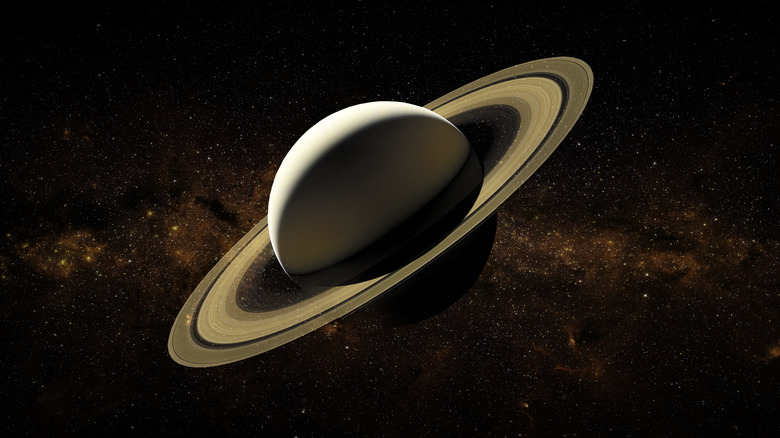Why Some Planets Have Rings
Thinking back to grade school, does anyone remember those little solar system dioramas? Maybe you got lucky and had an industrious parent help you to make a spinning model of our tiny cosmic backyard. In case you need a refresher, there are nine planets (okay, eight now — sorry, Pluto) and a big ball of flaming gas that we rely on for life. Ours is the "third rock from the sun," so to speak: the blue one stuffed with plastic trash and bipedal apes staring at bright rectangles in their hands.
You also might remember that some of our solar system's planets have rings circling around them. Four, in fact: Jupiter, Saturn, Uranus, and Neptune, although Saturn (depicted above) gets the most attention for having the most blinged rings. They look pretty cool, but Earth doesn't have one. But don't be sad; we've got the moon. Its gravity is not only the reason why we have tides, but maybe even why we've got life on Earth at all (via Scientific American).
So how did those rings get there? There are a few options, but one of them points to the same way the moon got there: a galactic car crash, as Universe Today explains. In the remote past, some asteroid might have hit some other celestial body. The fragments didn't coalesce, but scattered and got locked in a planet's orbit. Or, a planet's gravity just grabbed a passing asteroid and shook it apart. Bam: instant cosmic accessory.
Vanishing hoops of rock and ice
We can assume that any ring circling any planet was caused by similar means, no matter the solar system. There are only so many ways it can happen. But even looking only at our tiny cosmic backyard, we can learn a lot about planetary rings. One thing to note: It's 100% possible for an asteroid to "collide" with a planet like Jupiter, even though Jupiter is made of gas. This happened as recently as September 13, 2021, when an amateur astronomer in Brazil recorded the incident (via Space).
Fun fact time: It isn't the case that there's only one, wide, flat band per planet. Neptune, for instance, has five full rings and four semi-ringed "arcs," as NASA explains. We even know how wide some of them are and how far away from the planet. The Leverrier ring, for instance, is a thin 15 kilometers (9.3 miles) wide, and 53,200 kilometers (~33,100 miles) from Neptune's center. As for materials, rings are made of billions of bits of rock and ice, ranging from as big as a house to microscopically small, as the University of Colorado at Boulder states.
Unlike a ring's symbolically eternal shape, though, planetary rings won't last forever. Saturn, for instance, is losing its rings bit by bit. Gravity pulls down their rock and ice at a rate of an "Olympic-sized swimming pool [every] half an hour," as CNN says. Within a short 100 million years, the rings will be gone.

